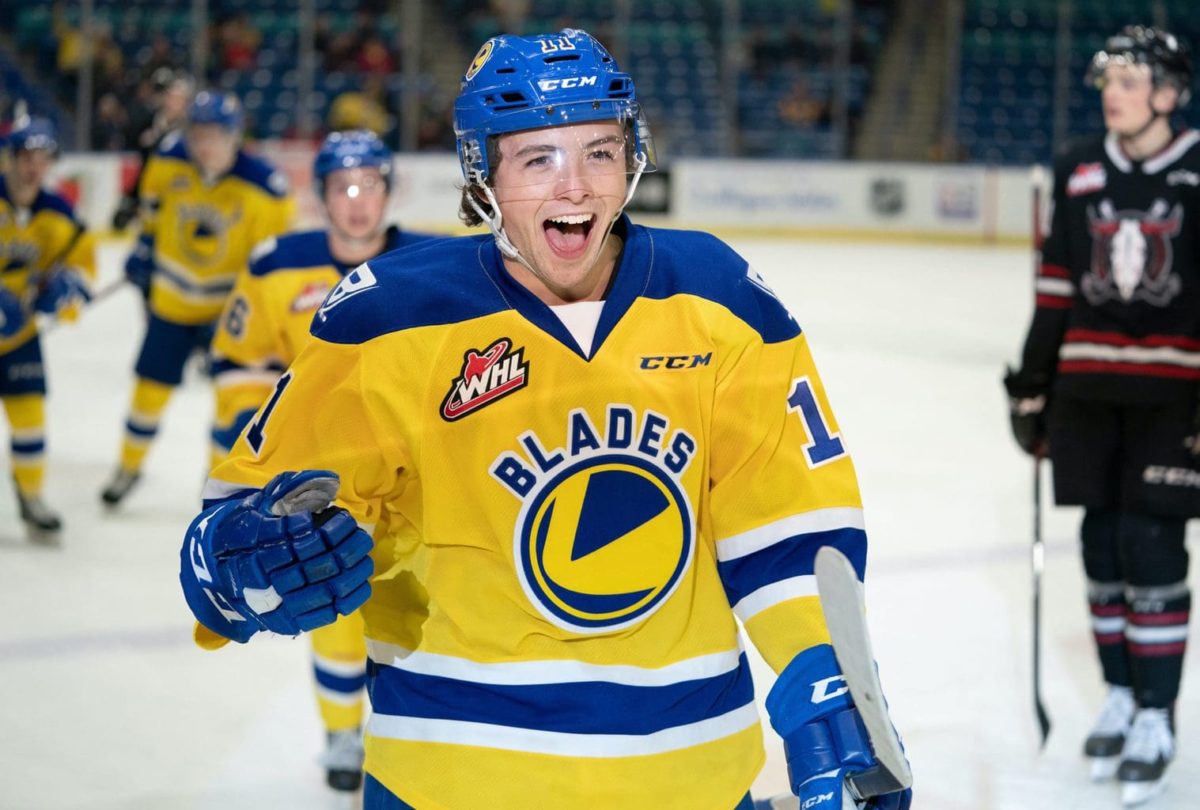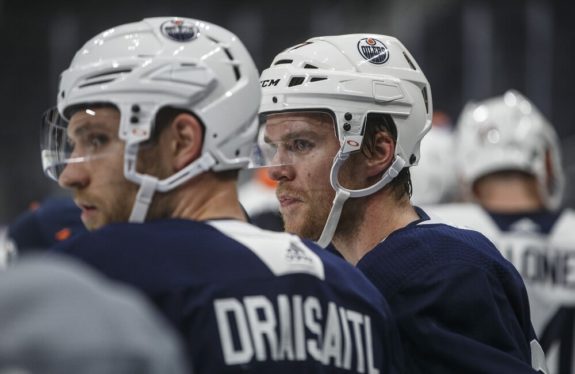When Doug Wilson stated that the Sharks were “not as far away as people think” during the 2020-21 season, he wasn’t wrong (from ‘Doug Wilson on Sharks Outlook: ‘We’re not as far away as people think,” The Mercury News, May 12, 2021). The problem was they didn’t have the talent in their pipeline to compensate for the absences of Joe Pavelski, Evander Kane, and Joonas Donskoi. Those holes have been so glaring for the past three seasons, that it’s easy to lose sight of the fact that their replacements could already be in the system.
Though it was labeled a “reset” in 2019, I’ll address the big pink elephant in the room for what it was and is; a rebuild. The Sharks are now in the fourth season of their unspoken rebuild. That may not be what fans of the “Tank for Bedard” sweepstakes want to hear, but the fact that they’ve quietly undergone such a process bodes well for the near future. In fact, if general manager Mike Grier plays the upcoming trade deadline correctly, the Sharks could accelerate that process. I’ve alluded to the fact that they could return to contention sooner than later, but here’s an in-depth blueprint as to why and how that can happen.
Sharks’ Prospects Could Be Nearing Top-6 Capabilities
If increased secondary scoring has done anything this season, it’s shone a spotlight on the Sharks’ lack of top-line scoring talent. That is to reiterate the Pavelski, Kane, and Donskoi-sized holes in the lineup. With limited cap space, the plug was going to have to come from within. As I’ve expounded upon in prior pieces, the Sharks may have those top-six options in their system. If the first quarter of the American Hockey League (AHL) season is any indication, the Sharks could be trading their sinking ship for a fancy new yacht ahead of schedule. That is to say, Tristen Robins, Thomas Bordeleau, William Eklund, and even Danil Gushchin could be the reinforcements the Sharks need.

Bordeleau (20 years old) has especially flourished, leading all first-year AHL players with 13 goals and 20 points in 29 games. Eklund has been just as impressive, leading the team with 21 points. Meanwhile, Robins and Gushchin aren’t far behind, with Robins posting an impressive nine goals and 15 points in 26 games and Gushchin sitting at 17 in 27 contests.
Oilers Serve as a Warning to the Draft Rebuild Approach
While drafting top talent is one of the primary keys to a successful rebuild, it’s not the only one. The Edmonton Oilers’ pure draft rebuild approach serves as a hard lesson to other NHL teams looking to revamp their lineup.
Between 2010-2016, the Oilers loaded up on top-five draft talent, consisting of Taylor Hall (first overall), Ryan Nugent-Hopkins (first overall), Nail Yakupov (first overall), Leon Draisatil (third overall), Connor McDavid (first overall), and Jesse Puljujarvi (fourth overall). Yet, in the seven seasons since 2015-16, they have missed the playoffs three times and advanced beyond the first round only once with their Western Conference Final appearance last season.
Related: San Jose Sharks Should Take a Chance on Puljujarvi
Furthermore, If the Sharks adopt the Oilers’ approach, their prospects could find themselves in a similar position to Hall in 2016 (from ‘Cult of Hockey: The Top 8 Reasons Why the Edmonton Oilers Traded Taylor Hall,’ Edmonton Journal, Jun. 29, 2016). He was the first-overall pick on a team brimming with young forward talent. So much so that they had to sacrifice some of it to compensate for their struggles on the back end.
Thus, picking from a buffet platter of talent for successive seasons is tempting. However, it can make it almost impossible to keep all that talent together in a salary-cap world. In correlation, if the Sharks commit to a full rebuild now, one of their prior top picks in Eklund, Robins, or Bordeleau could similarly be the odd man (or men) out.
All that to say not all of the Oilers’ top-five picks panned out the way they had hoped. After they moved on from Hall, Yakupov became a bust and now, former fourth-overall pick Puljujarvi hasn’t panned out as projected either, igniting talks that his days could be numbered in Edmonton.

Despite having the top two scorers in the league in McDavid and Draisaitl, the Oilers have struggled to build around their dynamic duo. They’ve since been stuck somewhere in the middle, never quite being considered a powerhouse, but never bad enough to be out of the playoff picture. Now, a few mammoth contracts are preventing this top-heavy team from adding many complementary pieces to support their superstars. Sound familiar?
That’s why there’s a necessary balance between drafting and acquiring pieces in trade/free agency. Do the Sharks really want to risk the next 5-10 seasons simply to be a playoff team rather than a top contender? Though they may not have a McDavid and/or Draisaitl, performance projections indicate they have both quantity and quality in their pipeline.
Historically Deep 2023 Draft Couldn’t Come at a Better Time for the Sharks
With so many options beyond Bedard in the 2023 Draft, teams outside of the first overall pick have a good chance of selecting an immediate top-line talent. Therefore, if the Sharks miss out on the first-overall pick, ‘tanking’ for anything less would be pointless. Bearing that in mind, one more top-15 pick from the upcoming draft should solidify their next generation of contention. Though the results don’t reflect it yet, staying the course appears to be the best option for the organization moving forward.
Sharks Should Look to the Past to Mirror a Successful Future
There are uncanny contrasts between the current team and the pre-Joe Thornton era. Before the Thornton trade, as with the current club, the Sharks lacked top-six forward talent and were cemented at the bottom of the standings. The difference is they don’t have the financial flexibility they had then.

The Sharks know from firsthand experience that the impact of one or two players can change the entire dynamic of a team. After all, the last time they possessed the worst record in the NHL, they gained an immediate difference-maker in Thornton. This time around, that isn’t likely to come via the trade market with their cap constraints. The advantage today, unlike in 2005, is those types of players appear to be within their farm system and in larger numbers.
It’s not that one player suddenly makes a team great. It’s the trickle-down effect one or more can have throughout the lineup that changes the dynamic of a team’s style of play. Those dynamic players are currently circling the waters of the Sharks’ prospect pool. At this point, it’s not a matter of if, but when they will take over the next generation of memorable Sharks hockey.
Original concept by Josh Fitzpatrick
